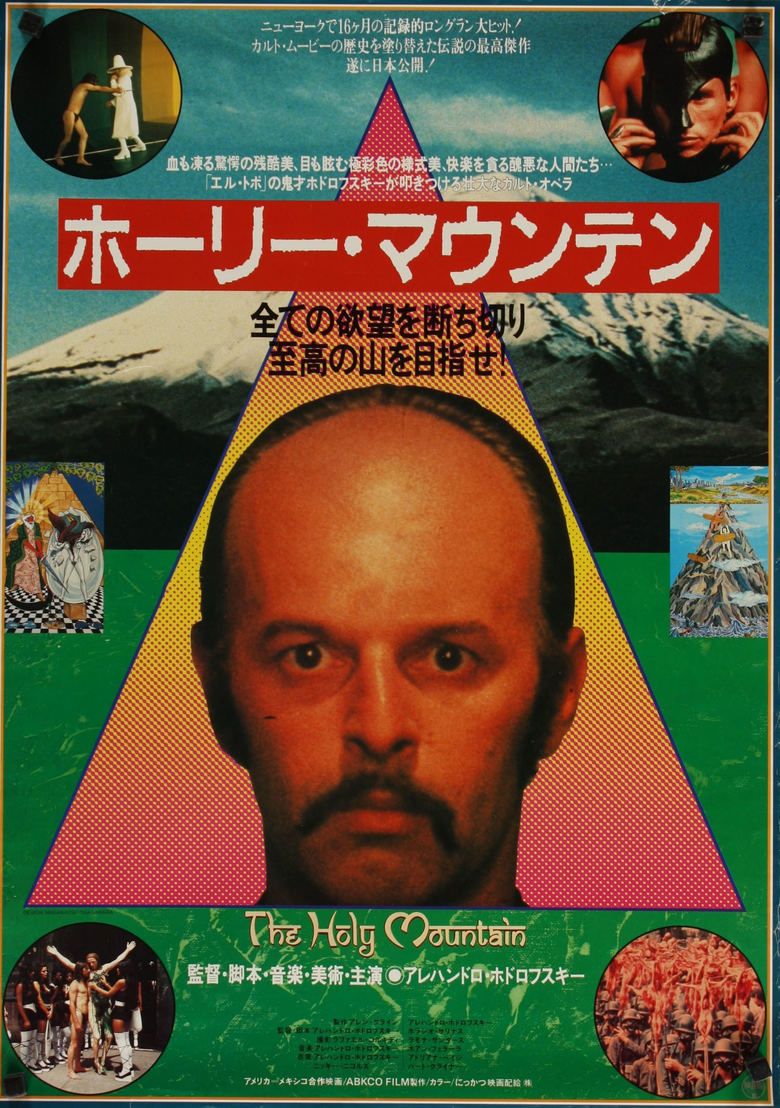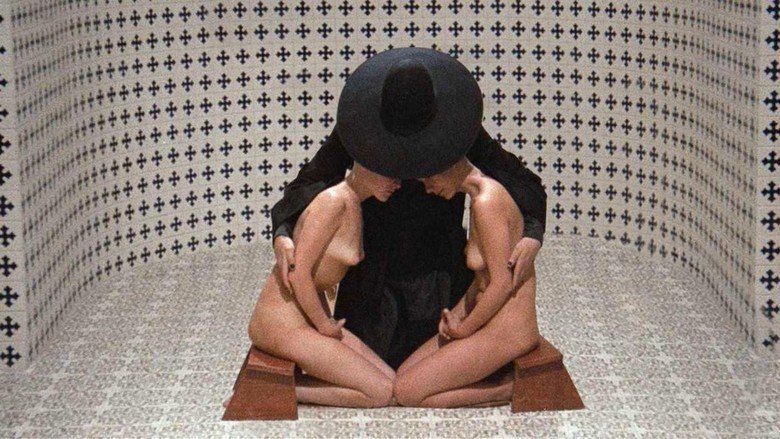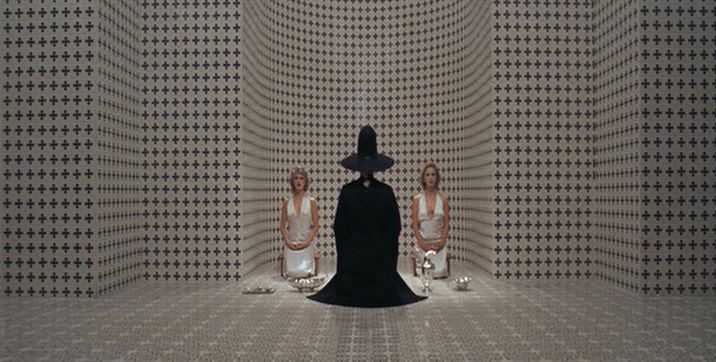The Holy Mountain (1973 film)
8.2 /10 1 Votes8.2
Budget 750,000 USD Genres Drama, Fantasy Language EnglishSpanish | 8/10 IMDb Duration Country MexicoUnited States | |||||||||||||||||||||||||||||||||
 | ||||||||||||||||||||||||||||||||||
Release date May 1973 (1973-05) (Cannes)27 November 1973 (1973-11-27) (United States)11 July 1975 (1975-07-11) (Mexico) Cast Alejandro Jodorowsky (The Alchemist), Horacio Salinas (The Thief), Zamira Saunders (The Written Woman), (Fon, He whose planet is Venus), Adriana Page (Isla, She whose planet is Mars), Burt Kleiner (Klen, He whose planet is Jupiter)Similar movies Bare , Fish Tank , Slums of Beverly Hills , It's Kind of a Funny Story , Veronika Decides to Die , Skipped Parts | ||||||||||||||||||||||||||||||||||
A Mexican master (Alexandro Jodorowsky) leads a Christ figure (Horacio Salinas) and other disciples to a mountain of immortal wise men.
Contents

La montana sagrada (The Holy Mountain, reissued as The Sacred Mountain) is a 1973 Mexican-American surreal fantasy film directed by Alejandro Jodorowsky, who also participated as an actor, composer, set designer and costume designer on the film. The film was produced by Beatles manager Allen Klein of ABKCO Music and Records, after Jodorowsky scored an underground phenomenon with El Topo and the acclaim of both John Lennon and George Harrison (Lennon and Yoko Ono put up production money). It was shown at various international film festivals in 1973, including Cannes, and limited screenings in New York and San Francisco.

A Mexican master (Alexandro Jodorowsky) leads a Christ figure (Horacio Salinas) and other disciples to a mountain of immortal wise men.
Plot
A man (later identified as a thief) representing The Fool, a tarot card typically depicting a young man stepping off a cliff, lies on the ground with flies covering his face like excrement. He is befriended by a footless, handless dwarf (representing the Five of Swords: defeat) and goes into a city to make money from tourists. The thiefs resemblance to Jesus Christ inspires some to use his likeness for the crucifixes that they sell by casting an impression of his face and body. After a dispute with a priest who rejects the thiefs likeness of himself, the thief eats off the face of his wax statue and sends it skyward with balloons, symbolically eating the body of Christ and offering "himself" up to Heaven. Soon after, he notices a crowd gathered around a tall tower, where a large hook with a bag of gold has been sent down in exchange for food. The thief, wishing to find the source of the gold, ascends the tower, finding the alchemist (played by Jodorowsky) and his silent female assistant.
After a confrontation with the alchemist, the thief defecates into a container. The excrement is transformed into gold by the alchemist, who proclaims: "You are excrement. You can change yourself into gold". The thief accepts the gold, but when shown himself in a mirror he angrily smashes the mirror with the gold, and the alchemist takes the thief as an apprentice.

The thief is introduced to seven people who will accompany him on his journey; they are said to be the most powerful but mortal, like himself. They are related to planets in astrological terms and portrayed with broad-brush satire, each personifying the worst aspects of his or her planets supposed characteristics. The seven consist of: a cosmetics manufacturer (male, Venus), a weapons manufacturer (female, Mars), a millionaire art dealer (male, Jupiter), a war toy maker (female, Saturn), a political financial adviser (male, Uranus), a police chief (male, Neptune) and an architect (male, Pluto). They are gathered together by the alchemist who instructs them to burn their money and wax images of themselves. Together with the alchemist, the thief and the alchemists assistant, they form a group of ten.
Several scenes follow, wherein the characters are led by the alchemist through transformation rituals. They carry staffs topped with their planets symbols; the alchemists symbol is the Sun, the thiefs is the Moon and the alchemists silent assistant is Mercury. They all journey by boat to Lotus Island to gain the secret of immortality from nine immortal masters who live on a holy mountain. Once on Lotus Island they are sidetracked by the "Pantheon Bar", a cemetery party where people have abandoned their quest for the holy mountain and instead engage in drugs, poetry or acts of physical prowess. Leaving the bar behind, they ascend the mountain and each have personal symbolic visions representing each characters worst fears and obsessions. Near the top, the thief is sent back to his "people" along with a young prostitute and an ape who has followed him to the mountain. The rest confront the cloaked immortals, who are shown to be only faceless dummies. The alchemist then breaks the fourth wall and reveals the film apparatus just outside the frame (cameras, microphone, lights and crew) and says "Zoom back camera!", instructing everyone, including the audience of the film, to leave the holy mountain. "Real life awaits us", he says, and the film ends.
Cast
Inspiration
The film is based on Ascent of Mount Carmel by John of the Cross and Mount Analogue by Rene Daumal, who was a student of George Gurdjieff. In this film, much of Jodorowskys visually psychedelic story follows the metaphysical thrust of Mount Analogue. This is revealed in such events as the climb to the alchemist, the assembly of individuals with specific skills, the discovery of the mountain that unites Heaven and Earth "that cannot not exist", and symbolic challenges along the mountain ascent. Daumal died before finishing his allegorical novel, and Jodorowskys improvised ending provides a way of completing the work (both symbolically and otherwise).
Preparation
Before the principal photography would commence, Jodorowsky and his wife spent a week without sleep under the direction of a Japanese Zen master.
The central members of the cast spent three months doing various spiritual exercises guided by Oscar Ichazo of the Arica Institute. The Arica training features Zen, Sufi and yoga exercises along with eclectic concepts drawn from the Kabbalah, the I Ching and the teachings of George Gurdjieff. After the training, the group lived for one month communally in Jodorowskys home before production. Thereafter, the filming started in spring of 1972. The film was shot sequentially, and entirely in Mexico at a budget of $750,000.
Jodorowsky was also instructed by Ichazo to take LSD for the purpose of spiritual exploration. He also administered psilocybin mushrooms to his actors during the shooting of the death-rebirth scene.
Release
The film was completed just in time for the 1973 Cannes Film Festival, where it was much awaited. Director Jodorowsky, edited out twenty minutes of dialogue from the film, with the intention of removing as much dialogue as he could. The film had its premiere at Waverly Theatre, an art house movie theater in New York City on November 29, 1973, where it had restricted run on Friday and Saturday midnights for sixteen months. At a few places it was released as a double bill with Jodorowskys 1970 film, El Topo, and eventually became a cult film with its influence on the popular culture.
In 2010, the Alamo Drafthouse held a screening of The Holy Mountain as part of their "High for the Holidays" event. To commemorate this event, a limited-edition movie poster was designed by German artist Florian Bertmer.
Home media
The film was never given wide release until over 30 years following its original premiere, when a restored print toured the United States, screening with El Topo, and released in DVD format from 1 May 2007. A Blu-ray was released on 26 April 2011.
References
The Holy Mountain (1973 film) WikipediaThe Holy Mountain (1973 film) IMDb The Holy Mountain (1973 film) themoviedb.org
